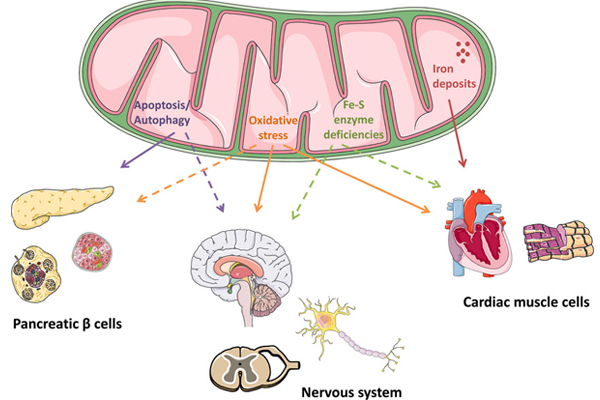Alternative Treatment of Friedreich’s ataxia
Abstract
Friedreich’s ataxia (FA) is a rare genetic, neurodegenerative movement disorder. The disorder is characterized by impaired muscle coordination (ataxia) because of nervous system damage which affects the spinal cord. The disorder typically hampers muscle movement in the limbs (arms and legs); thereby posing difficulties with walking, and also causing various other problems. The disorder, which begins in childhood, requires timely management because it is a progressive condition that becomes worse over time. Planet Ayurveda offers some excellent Herbal Products for Natural Management of Friedreich’s ataxia.
Friedreich’s ataxia: Overview
Friedreich’s ataxia – also called spinocerebellar degeneration – is a progressive disorder of the nerves and muscles. The disorder was first described in the 1860s by German doctor Nikolaus Friedreich.
Friedreich’s ataxia is a rare and inherited condition that damages certain parts of the brain and the spinal cord, because of which the nerves which are responsible for controlling the movement of the limbs get adversely affected. The damage to the nervous system in patients suffering from the disorder impairs muscle coordination because of a buildup of iron.
The age of the onset of Friedreich’s ataxia is usually between 5 and 15 years. The disorder can affect boys as well as girls.
As Friedreich’s ataxia progresses with time, the patients usually require a wheelchair after 15-20 years of the onset of the disorder. In severe cases, the patients can eventually become incapacitated, as they lose complete control over limb movements. Overall, the disorder not only causes progressive impairment of muscle coordination, but can also cause several complications involving the heart, vision, hearing, spine, and feet.

Causes of Friedreich’s ataxia
The key cause behind Friedreich’s ataxia is mutations in the copies of the FXN gene which the patients of the disorder inherit from their parents. The FXN is the genetic code for a protein known as ‘frataxin’ which ensures proper functioning of mitochondria (the energy-producing parts of the nerve and heart cells).
The mutations in the FXN gene adversely affect the production of ‘frataxin’ protein in Friedreich’s ataxia patients, thereby triggering a gradual degeneration of the nerve fibers in the spinal cord and peripheral nerves. The FXN-gene mutations, therefore, damage the nervous system, the spinal cord, and the nerves that control the limb movements.
Symptoms of Friedreich’s ataxia
Friedreich’s ataxia makes it difficult for the patients to coordinate the movements of their arms and legs. In particular, some of the symptoms of the disorder are:
- Walking difficulties
- Muscle weakness
- Slurred speech (Dysarthria)
- Loss of hearing
- Involuntary movement of the eyes
- Lack of reflexes in the legs
- Clubfoot or other foot deformities
- Spine curved to one side (Scoliosis)
- Chest pain
- Heart palpitations
- Shortness of breath.
Treatment of Friedreich’s Ataxia
There is no specific Treatment for Friedreich’s ataxia. The management of the disorder is largely focused on treating the symptoms with the help of medications, physical therapy, and the use of walking aids, prostheses, and wheelchair. In some patients, the treatment may also involve a surgical procedure or non-surgical interventions for curing the curvature of the spine and foot deformities.
Friedreich’s ataxia can also be managed naturally with the help of herbal formulations prepared in accordance with the guidelines given in ancient Ayurvedic texts for treating the neurodegenerative movement disorder. Planet Ayurveda offers the following herbal products for natural management of Friedreich’s ataxia:
1. Brahmi Capsules
The standardized extract of ‘Brahmi’ herb (Bacopa Monneiri) is used for the preparation of these capsules. The herb has immense therapeutic value and is an excellent health tonic, aphrodisiac and memory enhancer.
The use of these capsules is beneficial in managing Friedreich’s ataxia because the Brahmi herb has the ability to strengthen the nervous system, promote mental health, improve memory and concentration, re-build brain tissues, remove free radicals from the body, regulate blood pressure, and relieve inflammatory disorders.
Dosage:1 capsule, twice daily after meals with plain water.
2. Gotukola Capsules
The preparation of these capsules involves the use of pure and standardized extracts of ‘Gotukola’ herb (Centella asiatica). The herb is known for its immense medicinal value and its ability to promote overall health and well-being.
The symptoms of Friedreich’s ataxia can be managed with these capsules because Gotukola herb can maintain brain health, enhance memory, support healthy blood circulation in the body, maintain a healthy metabolic rate, and balance the Pitta dosha.
Dosage: 1 capsule, twice daily after meals with plain water

3. Ashwagandha Capsules
For preparing these capsules, a standardized extract of ‘Ashwagandha’ herb (Withania somnifera) is used. The potent herb is widely known for its anti-inflammatory properties and immense medicinal significance.
The use of these capsules is beneficial in managing Friedreich’s ataxia because Ashwagandha herb can enhance mental health, improve brain function, support nerve functions, enhance heart health, reduce metabolic imbalances, strengthen the muscles, manage inflammation, rejuvenate the body, and balance the Vata and Pitta doshas.
Dosage: 1 capsule, twice daily after meals with plain water
4. Boswellia Curcumin
These capsules are prepared from a combination of two potent anti-inflammatory herbal ingredients — Shallaki (Boswellia serrata) and Curcumin (Curcuma longa). The Shallaki herb is known for its ability to fight inflammation, while Curcumin is considered an excellent antioxidant.
The use of these capsules is beneficial for patients suffering from Friedreich’s ataxia because the two herbal components can promote neuro-protective activity, relieve pain and inflammation, support healthy joint function, reduce joint stiffness, and swelling, increase mobility, support immune health, and maintain a healthy cardiovascular system.
Dosage: 1 capsule, twice daily after meals with plain water
5. Shilajit Capsules
The standardized extract of ‘Shilajit’ herb (Asphaltum) is used for the preparation of these capsules. Shilajit herb has a lot of medicinal value and is considered an excellent adaptogen, restorative, rejuvenative and ‘Rasayana.’
People affected by Friedreich’s ataxia can benefit from the use of these capsules because Shilajit has the ability to maintain a healthy mind and a healthy body, rejuvenate brain cells, relieve mental and physical stress, enhance memory and concentration, improve the body metabolism, eliminate toxins from the body, strengthen the muscles, and purify the blood.
Dosage: 1 capsule, twice daily after meals with plain water
6. Yograj Guggul
These tablets are prepared from a combination of some extremely beneficial herbs, including Shuddh Guggulu (Commiphora mukul), Chitraka (Plumbago zeylanica), Pippali (Piper longum), Amalaki (Emblica officinalis), Haritaki (Terminalia chebula), Mustaka (Citrus rotundus), Jeeraka (Cuminum cyminum), Devdaru (Cedrus deodara), Ela (Eletteria cardamomum), Ardraka (Zingiber officinale), Yavani (Trachyspermum ammi), Karavi (Piper chaba), Ajamoda (Trachyspermum roxburghianum), Kushta (Saussurea lappa), Rasna (Pluchea lanceolata), Dhanyaka (Coriander), Gokshura (Tribulus terrestris), and Patra (Cinnamomum zeylanicum).
The use of these tablets can benefit patients affected by Friedreich’s ataxia because the herbal ingredients have the combined ability to manage nervous disorders, strengthen the neuromuscular system, maintain a healthy metabolism, support healthy muscles, treat bone and joint disorders, and balance the Vata dosha.
Dosage: 2 tablets, twice daily after meals with plain water
Conclusion
Planet Ayurveda Herbal Products for Natural Management of Friedreich’s ataxia are prepared from 100% pure and standardized herbs. The products are completely safe to use because they do not contain any chemicals, starch, yeast, artificial colors, preservatives, additives, fillers, or binders. However, it is recommended that patients suffering from Friedreich’s ataxia should use herbal products in consultation with an expert Ayurveda practitioner.


